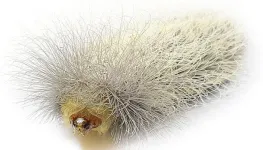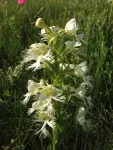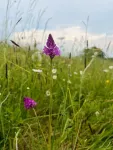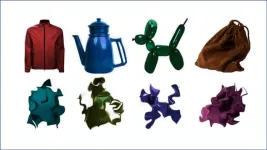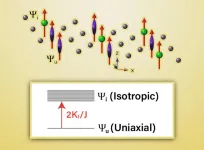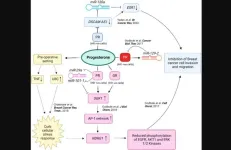(Press-News.org) Researchers at The University of Queensland have discovered the venom of a notorious caterpillar has a surprising ancestry and could be key to the delivery of lifesaving drugs.
A team led by Dr Andrew Walker and Professor Glenn King from UQ’s Institute for Molecular Bioscience found toxins in the venom of asp caterpillars punch holes in cells the same way as toxins produced by disease-causing bacteria such as E. coli and Salmonella.
“We were surprised to find asp caterpillar venom was completely different to anything we had seen before in insects,” Dr Walker said.
“When we looked at it more closely, we saw proteins that were very similar to some of the bacterial toxins that make you sick.”
This type of bacterial toxins bind themselves to the surface of cells and assemble into donut-like structures that form holes.
“It’s similar to the mechanism of box jellyfish venom – and as we’ve now found – caterpillar venom too,” Dr Walker said.
“The venom in these caterpillars has evolved via the transfer of genes from bacteria more than 400 million years ago.”
The asp caterpillar (Megalopyge opercularis, larva of a moth) is native to North America, where it is often found in oak or elm trees.
It might look innocuous, but its long hair-like bristles conceal venomous spines that can deliver an excruciating sting likened to touching burning coal or blunt force trauma – often sending victims to hospital.
“Many caterpillars have developed sophisticated defences against predators, including cyanide droplets and defensive glues that cause severe pain, and we’re interested to understand how they are all related,” Dr Walker said.
“Venoms are rich sources of new molecules that could be developed into medicines of the future, pesticides, or used as scientific tools.
“IMB’s investigations into the venom of snakes and spiders have already demonstrated their amazing potential, but caterpillar venoms are particularly understudied.
“Toxins that puncture holes in cells have particular potential in drug delivery because of their ability to enter cells.
“There may be a way to engineer the molecule to target beneficial drugs to healthy cells, or to selectively kill cancer cells.”
This research was published in Proceedings of the National Academy of Sciences (PNAS).
Researchers at The University of Queensland have discovered the venom of a notorious caterpillar has a surprising ancestry and could be key to the delivery of lifesaving drugs.
A team led by Dr Andrew Walker and Professor Glenn King from UQ’s Institute for Molecular Bioscience found toxins in the venom of asp caterpillars punch holes in cells the same way as toxins produced by disease-causing bacteria such as E. coli and Salmonella.
“We were surprised to find asp caterpillar venom was completely different to anything we had seen before in insects,” Dr Walker said.
“When we looked at it more closely, we saw proteins that were very similar to some of the bacterial toxins that make you sick.”
This type of bacterial toxins bind themselves to the surface of cells and assemble into donut-like structures that form holes.
“It’s similar to the mechanism of box jellyfish venom – and as we’ve now found – caterpillar venom too,” Dr Walker said.
“The venom in these caterpillars has evolved via the transfer of genes from bacteria more than 400 million years ago.”
The asp caterpillar (Megalopyge opercularis, larva of a moth) is native to North America, where it is often found in oak or elm trees.
It might look innocuous, but its long hair-like bristles conceal venomous spines that can deliver an excruciating sting likened to touching burning coal or blunt force trauma – often sending victims to hospital.
“Many caterpillars have developed sophisticated defences against predators, including cyanide droplets and defensive glues that cause severe pain, and we’re interested to understand how they are all related,” Dr Walker said.
“Venoms are rich sources of new molecules that could be developed into medicines of the future, pesticides, or used as scientific tools.
“IMB’s investigations into the venom of snakes and spiders have already demonstrated their amazing potential, but caterpillar venoms are particularly understudied.
“Toxins that puncture holes in cells have particular potential in drug delivery because of their ability to enter cells.
“There may be a way to engineer the molecule to target beneficial drugs to healthy cells, or to selectively kill cancer cells.”
Explainer video: https://youtu.be/OapU6vDbYDY
END
Caterpillar venom study reveals toxins borrowed from bacteria
Researchers have found toxins in the venom of asp caterpillars punch holes in cells the same way as toxins produced by disease-causing bacteria such as E. coli and Salmonella
2023-07-10
ELSE PRESS RELEASES FROM THIS DATE:
Global cooling caused diversity of species in orchids, confirms study
2023-07-10
Research led by the Milner Centre for Evolution at the University of Bath looking at the evolution of terrestrial orchid species has found that global cooling of the climate appears to be the major driving factor in their diversity. The results help scientists understand the role of global climate on diversity of species, and how our current changing global climate might affect biodiversity in the future.
One of the largest families of plants, there are around 28,000 species of orchids growing across the world. These plants are known for their huge variety of different sized and shaped flowers, so why are there so many species
Climate change driving speciation
Charles ...
Real-world context increases capacity for remembering colors
2023-07-10
Human memory is fundamental to everything we do. From remembering the faces of someone you just met to finding your cell phone that you just left on a table, one's "visual working memory"— the core cognitive system that retains visual information in an active state for a short period of time, plays a vital role. Prior work has found that visual working memory capacity is well correlated with other important cognitive abilities such as academic performance, and fluid intelligence, which includes general reasoning and problem solving, so understanding its limits is integral to understanding how human cognition works.
In the past, theories have proposed that an individual’s ...
Argonne scientist Shirley Meng recognized for contributions to battery science
2023-07-10
The Electrochemical Society (ECS) has selected scientist Shirley Meng of the U.S. Department of Energy’s (DOE) Argonne National Laboratory as the recipient of the 2023 Battery Division Research Award for innovative research on interfacial science, which has led to improved battery technologies.
A pioneer in discovering and designing better materials for energy storage, Meng serves as chief scientist of the Argonne Collaborative Center for Energy Storage Science (ACCESS) and as a professor at the Pritzker School of Molecular ...
Researchers make a surprising discovery about the magnetic interactions in a Kagome layered topological magnet
2023-07-10
A team from Ames National Laboratory conducted an in-depth investigation of the magnetism of TbMn6Sn6, a Kagome layered topological magnet. They were surprised to find that the magnetic spin reorientation in TbMn6Sn6 occurs by generating increasing numbers of magnetically isotropic ions as the temperature increases.
Rob McQueeney, a scientist at Ames Lab and project lead, explained that TbMn6Sn6has two different magnetic ions in the material, terbium and manganese. The direction of the manganese moments controls the topological state, “But ...
Deciphering progesterone’s mechanisms of action in breast cancer
2023-07-10
“The mechanisms underlying the observed effects of progesterone on breast cancer outcomes are unclear.”
BUFFALO, NY- July 10, 2023 – A new research perspective was published in Oncotarget's Volume 14 on July 1, 2023, entitled, “Deciphering the mechanisms of action of progesterone in breast cancer.”
A practice-changing, randomized, controlled clinical study established that preoperative hydroxyprogesterone administration improves disease-free and overall survival in patients with node-positive breast cancer. In this new perspective, researchers Gaurav Chakravorty, Suhail Ahmad, Mukul S. Godbole, Sudeep Gupta, Rajendra A. Badwe, ...
More data needed on lifestyle interventions for postpartum blood pressure control
2023-07-10
Hypertensive disorders of pregnancy such as preeclampsia and gestational hypertension occur in up to 10% of pregnancies and are associated with a three-fold increased risk of chronic hypertension and up to two-fold increased risk of cardiovascular disease when compared with healthy pregnancies. While the year after pregnancy is a critical time to address hypertension risk with lifestyle changes (healthy diet and exercise), the effects of lifestyle interventions on postpartum blood pressures are not well documented.
A new Boston University Chobanian & Avedisian School of Medicine study has found that there are few relevant studies on the ...
New biodegradable plastics are compostable in your backyard
2023-07-10
We use plastics in almost every aspect of our lives. These materials are cheap to make and incredibly stable. The problem comes when we're done using something plastic — it can persist in the environment for years. Over time, plastic will break down into smaller fragments, called microplastics, that can pose significant environmental and health concerns.
The best-case solution would be to use bio-based plastics that biodegrade instead, but many of those bioplastics are not designed to degrade in backyard composting conditions. They must be processed in commercial composting facilities, which are not accessible in all regions of the ...
Canned, frozen corn industry struggling across US growing regions
2023-07-10
URBANA, Ill. — For those whose primary experience with corn is the butter-drenched cob variety, it might come as a surprise that other forms of sweet corn are in trouble. A new University of Illinois Urbana-Champaign analysis shows sweet corn production for frozen and canned products has been steadily shrinking in the U.S. over the past 27 years, particularly in rainfed portions of the Midwest.
“The processing sweet corn industry [corn grown for canned and frozen products] was thriving in the U.S. throughout the 20th century. This type of production, ...
Ethics & Human Research, July-August 2023
2023-07-10
Antiracist Structural Intervention at the Emory University Institutional Review Board
Francois Rollin, Vanessa Van Doren, Jessica Alvarez, Rebecca Rousselle, Jada Bussey-Jones
Although racial and ethnic categories are social constructs without inherent biologic or genetic meaning, race and ethnicity impact health outcomes through racism. The use of racial categories in biomedical research often misattributes the cause of health inequities to genetic and inherent biological differences rather than to racism. Improving research ...
Unhealthy beverage consumption highest among economically-vulnerable households that rely on multiple food assistance programs
2023-07-10
Philadelphia, July 10, 2023 – A long-standing and contentiously debated question is the extent to which US federal food assistance programs contribute to or deter healthy beverage intake. Findings of a new study in the Journal of Nutrition Education and Behavior, published by Elsevier, show that while beverage intake patterns rarely differed between mothers and young children who participated only in the Supplementation Nutrition Program for Women, Infants, and Children (WIC), only the Supplemental ...
LAST 30 PRESS RELEASES:
Deep neural networks enable accurate pricing of American options under stochastic volatility
Collective risk resonance in Chinese stock sectors uncovered through higher-order network analysis
Does CPU impact systemic risk contributions of Chinese sectors? Evidence from mixed frequency methods with asymmetric tail long memory
General intelligence framework to predict virus adaptation based on a genome language model
Antibiotic resistance is ancient, ecological, and deeply connected to human activity, new review shows
Vapes, pouches, heated tobacco, shisha, cigarettes: nicotine in all forms is toxic to the heart and blood vessels
From powder to planet: University of Modena engineers forge a low-carbon future for advanced metal manufacturing
Super strain-resistant superconductors
Pre-school health programme does not improve children’s diet or physical activity, prompting call for policy changes, study finds
Autumn clock change linked to reduction in certain health conditions
AI images of doctors can exaggerate and reinforce existing stereotypes
Where medicine meets melody – how lullabies help babies and parents in intensive care
We may never be able to tell if AI becomes conscious, argues philosopher
AI video translation shows promise but humans still hold the edge
Deep ocean earthquakes drive Southern Ocean’s massive phytoplankton blooms, study finds
Without campus leftovers to pick through, the beaks of this bird changed shape during the pandemic
High-dose antibiotic does not reduce mortality in tuberculous meningitis
How many insects fly in the sky above the USA?
Could cheese protect your brain health?
Who faces more difficulty recovering from stroke?
Colliding galaxies create the brightest, fastest growing black holes at their center
New BrainHealth research reveals tradeoffs on sleep with cannabis use for chronic pain
Aging-US now on ResearchGate, enhancing visibility for authors and readers
'Molecular glue' stabilizes protein that inhibits development of non-small cell lung cancer
Mount Sinai Health System is recognized in 2025 Chime Digital Health Most Wired survey
From prey to predator: How carnivores spread beneficial fungi
Menopause symptoms may be frequent and have negative effects, according to female endurance athletes
US Congressmembers’ responses on X to mass shooting events differ along party lines
KAIST-UEL team develops “origami” airless wheel to explore lunar caves
Individual genetic differences render some therapies ineffective
[Press-News.org] Caterpillar venom study reveals toxins borrowed from bacteriaResearchers have found toxins in the venom of asp caterpillars punch holes in cells the same way as toxins produced by disease-causing bacteria such as E. coli and Salmonella
